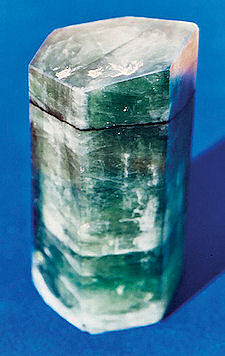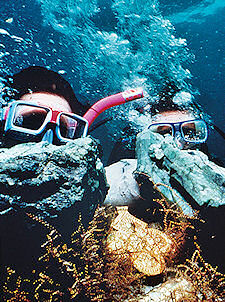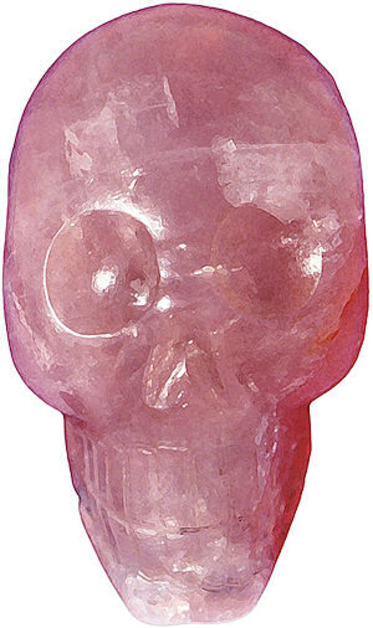Crystal skulls, priceless emeralds – a US dive team hit paydirt when they called in psychics to help locate a legendary treasure ship, and the work goes on, as John Christopher Fine discovers.

YEARS BEFORE THE LATEST INDIANA JONES movie about lost crystal skulls was even conceived, underwater explorers found real Aztec crystal skulls in a sunken Spanish shipwreck in very deep water off the coast of Florida.
The story is bizarre. Florida divers, commissioned by a South American family who were direct descendants of the wife of the conqueror of Mexico, Hernan Cortez, found the wreck somewhere off the Atlantic coast.
The exact location remains a secret because the find is in international waters more than 12 miles off the coast, so would be up for grabs on the high seas, where piracy is alive and well.
All we know is that the site is deep, at the limits of compressed air diving, and between Sebastian and Cape Canaveral.
Ever since 1993, Victor Benilous, his wife Sue and a small team of trusted divers have been raising treasures from the sunken wreckage of a Spanish aviso, or courier ship, that sank around 1757. At least, that's the date stamped on a silver bar the team recovered recently.
What makes the wreck extraordinary is that, according to Benilous, the Spanish ‘took a whole mountain to use as ballast, and were going to sort it out when they arrived in Spain'.
That mountain, from the jungles of Colombia, was an emerald mine. The ship sank after burning to the waterline, and its ballast contains clumps of emeralds, jewels and exquisite personal belongings of the passengers – a king's ransom of treasure.
‘The largest worked emerald is a magnificent six-sided gem that weighs 964 carats,' Benilous told me.
‘Research has identified the gem as the Isabella Emerald – a stone that was wanted by Queen Isabella, the Portuguese wife of Charles V.'
The deep-green oblong stone is so large that it overlaps the palm of a hand.
The queen had apparently hinted to Cortez that he should make her a present of the gem, but instead he gave it as a wedding gift to his second wife, Dona Juana de Zuniga.
A tennis pro from Argentina, known also for his treasure-hunting exploits in the jungles of South America, was approached by a family he had taught to play tennis and who, as it turned out, were descendants of the de Zuniga clan.
They had information about a ship that had been wrecked while carrying a messenger back from the New World to Spain with the Cortez treasure aboard, and never recovered.
The pro, who had been working in fashionable Palm Beach, Florida, had heard of the exploits of Victor Benilous, a restaurateur/art-collector/antiques expert/diver. He had been involved in excavating an unidentified deepwater wreck off Juno beach, said to date back to 1554.
‘The tennis pro approached me with the story of the emerald Queen Isabella wanted but couldn't have,' said Benilous. ‘I think the queen was still trying to woo Cortez for future gems.
‘We know Dona Juana de Zuniga followed her husband to Mexico on voyages. Emeralds were regularly being sent back to Spain.'
BENILOUS FORMED A TEAM and began researching the archives and de Zuniga family documents to find clues to the shipwreck's existence. ‘The de Zuniga family were second cousins to the king, and received many land grants from the Crown,' he explained.
Cortez had died in 1547, and much of the history of his family remains clouded. ‘We know that a courier came from Spain to the New World in 1756, more than 200 years after Cortez's death,' Benilous told me.
‘We believe he was bringing the de Zuniga family fortune back to Spain so that they could use the gems to entice the Crown to give the family more favours in land grants.'
The courier was returning to Spain with a small fast vessel, he said. ‘According to the ship's manifest, the cargo included a hundred chests of emeralds.' But the ship caught fire.
‘They were out to sea, and the only information about its position came from another captain, who saw the ship burning and reported that it had been a certain number of hours since they were in sight of land,' said Benilous.
Victor Benilous sent maps with plastic overlays to two psychics. ‘I had used the psychics in the past – one of them worked with the US government and helped locate lost submarines.
‘When the maps came back, they were marked in almost the same spot, only centimetres apart at that scale – in actuality, less than four miles apart.'
HAVING NARROWED THE LOCATION DOWN, Victor Benilous brought one of the psychics out aboard his dive vessel – and located seven sites.
‘We used a magnetometer, side-scan sonar and a bottom profiler. The instruments identified three anchors of the Spanish colonial period.
‘We eliminated those sites, and concentrated on the other four identified by the psychic. There was a lot of sand, but we discovered a ballast pile.
‘Diving in deep water, we found some charred ribbing on one site, and a silver bar dated 1757. The divers then located three Aztec crystal skulls.'

‘Psychics are very special people,' put in Sue Benilous. ‘I believed from the beginning, but when you see the results, you get goose-bumps.'
When the divers went down on the site where the ‘psychic energy' had been received, they discovered the largest of the crystal skulls – less than 3m from where the psychic had told them to dive!
The skulls, ranging in size from a marble to a tennis-ball, are rare. ‘So far we have been able to identify only six other Aztec ceremonial skulls,' Sue Benilous told me.
‘The largest is in the British Museum, and is about the size of a human skull. They are so finely polished that we really don't know how the Aztecs made them.'

The divers brought up conglomerates that ranged from the size of a football to that of a desk. It was while examining these lumps, fused together and corroded after long immersion in seawater, that amazing artefacts started to be found.

‘The Cortez-Zuniga family crest ring was found originally with the Isabella emerald,' said Victor Benilous, showing me the ring.
‘When the courier came from Spain in 1757 to see the magistrate who had the Isabella emerald, he had to show the signet ring before it could be turned over to him, and he took it aboard ship.'

Rings, precious stones and jewellery of great value are among the rare, beautiful treasure the divers have recovered.
WHILE CLEANING A LARGE CONGLOMERATE, the team found a matrix that weighed about 7kg. Holding it in his office in West Palm Beach, Victor shone a powerful light that radiated through the stone, creating a beautiful emerald glow like green fire.
‘About 40% of the stone is emerald. It comes to 25,000 carats plus,' he said, turning the massive stone over in his hands.
‘It was encrusted and white, and we boiled it. I used hair-spray to keep it nice and make it look shiny like this – without having a gemologist polish it.'
The massive rough emerald had captured the imaginations of adventurers for centuries before its discovery. It is the largest in the world, and the greatest treasure ever recovered under the sea.
Among other treasures brought up by the divers is a gold cross studded with seven cabochon emeralds. ‘The biggest stone is 83mm, the smallest 53mm,' said Benilous.

‘The emeralds are top gem quality, and the gold is almost 22 carats.' Other rings included a 17.5-carat emerald set in gold, with two small garnets on each side.
Among the finds were many rough, uncut emeralds. ‘We went through literally thousands and thousands of emeralds, and found a gem-quality stone that was translucent,' explained Sue Benilous.

‘It was 42 carats. We kept the thickness, but cutting and polishing it we lost 50% of the weight of the stone.' She held out the magnificent gem. In the bright sunshine, it radiated a natural brilliance rarely found in unadulterated emeralds.
Writing in American Gemcutter Bulletin, expert gemologist Robert A Silverman said: ‘Ninety-nine percent of all emeralds are dyed and oiled.
The industry is trying to force, if a stone is enhanced, (that) it be mentioned.' To see a brilliant natural gem give off such deep green fire proved the shipwreck stone's value and rarity.
A fine mosaic consisting of thousands of fragments of gems, some only the thickness of two human hairs, was also found.
‘It probably took someone eight or nine years to make something like this,' said Victor Benilous, holding the mosaic in the palm of his hand. ‘From our research, we believe it to be from the neo-classic period, made during the early 1700s.
‘It was found wrapped in four inches of material – the coverings had swelled up over the years. Apparently the outside box broke open and it was inside another box. In there were the cross and the Crown ring.'
The divers are still trying to piece evidence from the mystery ship together. A courier vessel rather than a standard passenger ship, it would have carried no more than 20 passengers.
‘Part of the original manifest shows that the ship carried 100 chests of emeralds,' said Benilous. ‘Back then, emeralds didn't have the great value they have today.' He smiled, knowing that a top-quality emerald can fetch $15,000 per carat.
MORE TREASURE REMAINS on the bottom, and while the team is naturally vague about the wreck's exact location, it is certain that what they have found amounts to the most valuable cargo ever recovered from a sunken ship.
That it is associated with one of the most controversial and notorious conquistadors of the New World only enhances its value.
The story underscores the cruel history of the conquest of the New World and the destruction of native cultures, their advances in science and the arts all but eradicated by religious repression.
Aztec and Mayan artefacts recovered by the divers are rare examples saved for history, and the crystal skulls among the most unusual ever discovered.
Currently everything recovered from the shipwreck is preserved in vaults by the salvors. The collection is intact, and plans are being discussed with major institutions, private and public, to display the artefacts.
Conservation efforts continue to remove artefacts from conglomerates, to clean and preserve them.
Soon the salvors hope to be able to put together a major display, offering visitors the chance to learn about the history of conquest of the Aztecs and archaeology of underwater salvage.
In the case of Indiana Jones and the crystal skulls, the tale was only fiction. The ocean explorers who have recovered personal treasures of Hernan Cortez are the real thing.

